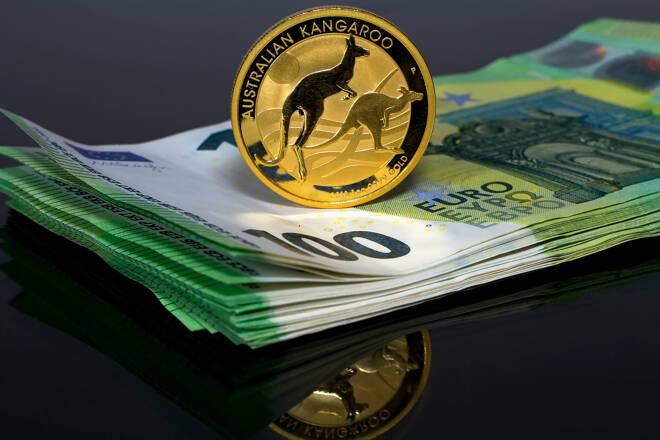Advertisement
Advertisement
AUD to USD Forecast: Aussie’s Fate Amid China Concerns and US Inflation Data
By:
Balancing US inflation concerns, the Aussie dollar awaits Beijing's stimulus measures amidst economic uncertainty.
Highlights
- AUD/USD dipped by 0.05% on Tuesday; Aussie consolidated after Monday’s 0.85% rally, ending at $0.64256.
- Despite lowered forecasts, the Australian dollar stands firm; China’s economic resilience cited.
- US CPI Report in focus: a rise in annual inflation expected; core inflation foreseen to drop.
Tuesday Overview
On Tuesday, the AUD/USD slipped by 0.05%. Consolidating a 0.85% rally from Monday, the Aussie Dollar ended the session at $0.64256. The Australian Dollar rose to a high of $0.64398 before falling to a low of $0.64084.
Aussie Dollar Trajectory Hinged on China Outlook
The Australian dollar remained stable on Tuesday despite lowered growth forecasts for China. Chinese officials asserted their economy is still resilient and hasn’t collapsed.
The spokesperson, citing US President Joe Biden and Australian Treasurer Jim Chalmers concerns about the Chinese economy, assured the media that the economy remains intact. The assurances comforted investors and cushioned any potential decline for the AUD/USD. Investors remain hopeful of a more meaningful stimulus package from Beijing to reboot the ailing economy.
A declining macroeconomic situation in China would negatively affect Australia, as China constitutes one-third of Australia’s exports. Over 40% of Australia’s economy is trade-based, making it vulnerable to weak demand as a commodity exporter. Trade provides about 20% of Australia’s jobs and influences RBA decisions.
This morning, investors will remain sensitive to commentary from Beijing. Further stimulus measures should further consolidate a return to the $0.64 handle. However, the US economic calendar and the US CPI Report will likely have the final say.
US CPI Report to Decide the Fed Interest Rate Trajectory
The US CPI Report is today’s focus. Predictions indicate annual inflation rising from 3.2% to 3.6%, but core inflation decreasing from 4.7% to 4.3%. Investors hope this drop will prompt the Fed to hit the brakes.
US inflation forms part of the Fed’s dual mandate. The Fed has an inflation target of 2%. Elevated inflation forces the Fed to lift interest rates higher to curb spending and demand-driven inflation.
The likelihood of a September Fed pause rose slightly to 93% from 92% between Monday and Tuesday. Meanwhile, there’s uncertainty in the markets about the November rate decision, with the CME FedWatch Tool indicating a 40.4% chance of a 25-basis point hike, up from 38.4% on Monday.
Hotter-than-expected US core inflation figures would fuel bets on a November move. Importantly, uncertainty toward the September policy decision would also test buyer appetite for the AUD/USD.
Short-Term Forecast
The near-term trend hinges on the US CPI Report and Beijing stimulus measures. Cooler-than-expected US inflation numbers and a Beijing stimulus package would bring $0.65 into play.
AUD/USD Price Action
Daily Chart
The AUD/USD remained above the $0.63854 support level and trend line. However, the 50-day and 200-day EMAs continued to send bearish price signals. Softer-than-expected US inflation figures would support an AUD/USD move toward the $0.64900 resistance level.
However, a lack of stimulus from Beijing and a hotter-than-expected US CPI Report would likely see the AUD/USD target the $0.63854 support level and trend line.
The RSI reading of 43.85 indicates the AUD/USD has room for a fall to sub-$0.64 before entering oversold territory.
4-Hourly Chart
The AUD/USD hovers above the 50-day EMA, signaling short-term bullishness, but below the 200-day EMA, indicating long-term bearishness.
A continued hold above the 50-day EMA would bring the 200-day EMA and the $0.64900 resistance level into play. However, selling pressure will intensify at $0.64900, with the 200-day EMA confluent with the resistance level.
A break below the 50-day EMA would give the bears a run at the $0.63854 support level. However, US core inflation must signal further Fed rate hikes to bring sub-$0.64 into play.
Considering the RSI at 53.97, the Aussie dollar can target $0.6450 before entering overbought territory.
About the Author
Bob Masonauthor
With over 28 years of experience in the financial industry, Bob has worked with various global rating agencies and multinational banks. Currently he is covering currencies, commodities, alternative asset classes and global equities, focusing mostly on European and Asian markets.
Advertisement
